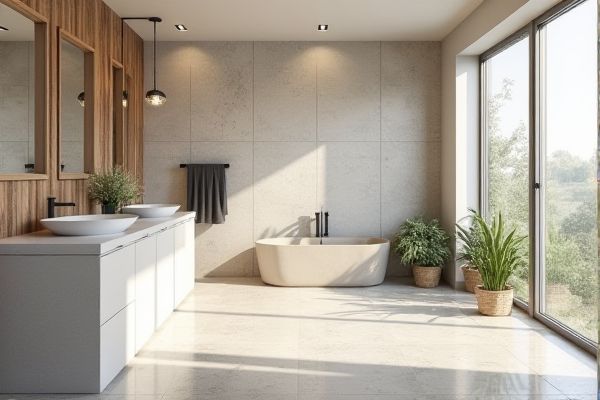
Porcelain tile backsplashes offer superior durability and water resistance compared to ceramic tiles, making them ideal for high-moisture kitchen environments. Explore this article to discover which backsplash option best suits your style and functional needs.
Table of Comparison
| Feature | Porcelain Tile Backsplash | Ceramic Tile Backsplash |
|---|---|---|
| Material Composition | Denser, finer clay fired at higher temperatures | Less dense clay fired at lower temperatures |
| Durability | Highly durable, resistant to chips and scratches | Moderately durable, more prone to damage |
| Water Absorption | Low absorption (<0.5%), highly water-resistant | Higher absorption (3-7%), less water-resistant |
| Stain Resistance | Superior stain and chemical resistance | Moderate stain resistance, can absorb stains over time |
| Design Options | Wide variety of styles, colors, and textures | Varied but generally fewer design options |
| Cost | Generally more expensive | More budget-friendly |
| Installation | Harder to cut and install due to hardness | Easier to cut and install |
| Maintenance | Low maintenance, easy to clean | Requires regular sealing and cleaning |
Introduction to Porcelain and Ceramic Tile Backsplashes
Porcelain tile backsplashes offer superior density and water resistance compared to ceramic tile, making them highly durable for kitchen and bathroom applications. Ceramic tile backsplashes are typically more affordable and come in a wider variety of colors and patterns, providing versatile design options for homeowners. Both materials require proper sealing and maintenance to preserve their appearance and performance in high-moisture areas.
Composition and Manufacturing Differences
Porcelain tiles are made from finer, denser clay and fired at higher temperatures than ceramic tiles, resulting in a harder, more durable surface ideal for backsplashes exposed to moisture and heat. Ceramic tiles consist of a mixture of red, white, or brown clay with other natural materials, fired at lower temperatures, making them slightly more porous and less resistant to impacts. The manufacturing process of porcelain involves vitrification, which reduces water absorption to less than 0.5%, whereas ceramic tiles typically have higher porosity, affecting longevity and stain resistance in backsplash applications.
Appearance and Design Options
Porcelain tile offers a sleek, polished look with a wide range of colors and patterns due to its dense composition, making it ideal for modern and high-end backsplash designs. Ceramic tile provides more traditional and artisanal aesthetics, featuring varied textures and hand-painted patterns that bring warmth and character to your kitchen. Your choice depends on whether you prefer the refined elegance of porcelain or the versatile charm of ceramic for your backsplash.
Durability and Strength Comparison
Porcelain tile backsplash offers superior durability and strength compared to ceramic tile, as it is made from denser clay and fired at higher temperatures, resulting in increased resistance to scratches, moisture, and stains. Porcelain tiles have a lower water absorption rate, typically below 0.5%, making them ideal for kitchen environments exposed to humidity and spills. Ceramic tiles, while durable, are more porous and prone to chipping, requiring additional sealing to enhance their longevity in high-traffic backsplash areas.
Water Resistance and Porosity
Porcelain tile offers superior water resistance and lower porosity compared to ceramic tile, making it an excellent choice for backsplashes exposed to moisture. Ceramic tiles have higher porosity, which can allow water to seep through grout lines if not properly sealed, potentially leading to mold or damage. Choosing porcelain for your backsplash ensures enhanced durability and easier maintenance in wet kitchen environments.
Maintenance and Cleaning Ease
Porcelain tile backsplashes offer superior maintenance and cleaning ease due to their dense, non-porous surface that resists stains, moisture, and bacteria buildup better than ceramic tiles. Ceramic tile backsplashes require more frequent sealing and careful grout cleaning to prevent discoloration and mold growth, increasing upkeep efforts. Porcelain's durability and low absorption rate make it an ideal choice for hassle-free long-term backsplash maintenance.
Installation Process and Requirements
Porcelain tile backsplashes require precise cutting tools and longer curing times due to their density and hardness, often necessitating a wet saw with a diamond blade for clean edges. Ceramic tile backsplashes are easier to install with standard tile cutters and allow quicker adhesive setting, making them ideal for DIY projects with basic tools. Both materials require a properly prepared, smooth, and moisture-resistant surface to ensure long-lasting adhesion and durability.
Cost Analysis: Porcelain vs Ceramic
Porcelain tile backsplashes generally cost more than ceramic tiles due to their denser composition and higher manufacturing process expenses, with prices ranging from $5 to $15 per square foot compared to ceramic's $1 to $7 per square foot. Despite the higher upfront cost, porcelain offers superior durability, stain resistance, and moisture impermeability, which can reduce long-term maintenance and replacement expenses. Ceramic tiles remain a budget-friendly option for backsplash projects, especially suitable for low to moderate traffic areas and simpler kitchen designs.
Pros and Cons of Each Material
Porcelain tile backsplashes offer superior durability, water resistance, and a dense composition that withstands heavy use, making them ideal for kitchens with high moisture. Ceramic tile backsplashes provide a more affordable option with a wider variety of colors and patterns, but they are less dense and more prone to chipping or cracking under impact. Your choice depends on the balance between budget, design preferences, and the level of durability required for your kitchen environment.
Which Tile Is Best for Your Backsplash?
Porcelain tile offers superior durability, water resistance, and stain resistance compared to ceramic tile, making it an excellent choice for kitchen backsplashes exposed to moisture and heat. Ceramic tile is often more affordable and easier to cut, providing greater design flexibility and a wide range of colors and patterns. For long-lasting performance and minimal maintenance, porcelain tile is best, while ceramic tile suits budget-conscious projects prioritizing aesthetic variety.
 homyna.com
homyna.com